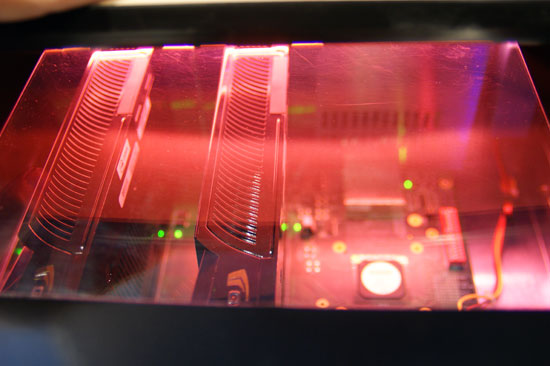This article may go a little further beyond the normal tech scope of this blog, but the release today of over 8 articles by pro tech sites on the subject (which I had already done work researching and posting about) has convinced me to repost my original work and additional information here.
SLI and CrossfireX are Nvidia and ATIs respective technologies for combining multiple Graphics Cards in a single computer system. While most of us get along just fine (or otherwise) with a single GPU, enthusiasts have the option of utilizing two or three (or four) GPUs to supercharge their gaming performance. Scientists have also discovered that these multi-GPU setups can greatly benefit compute intensive research applications such as Folding@Home. ATI entirely replaced their high-end GPUs with their two high performance cards fused onto a single circuit board, creating the impressive 4870X2 (and previously the 3870X2) as a result.

All of this technology is run by either SLI and Crossfire, technologies that attempt to share video rendering load over several GPUs by having each GPU render every other frame or half (or a third) of each frame. Problem is, in most cases performance scaling is not linear. In other words, two graphics cards don’t give you twice as much performance, maybe 70% extra at best. A third and fourth GPU may only increase performance 10% and then 5%, in many cases. Getting games to scale properly is extremely hard work for the developer and coders responsible for SLI and CrossFireX functionality. It is very hard to justify 3 GPUs getting you 50 FPS for a total cost of 900 dollars when a single GPU will get you 30 FPS. Additionally, the cards are using 600 watts when you could be using 200 much more efficiently. While SLI and CrossfireX have been slowly improving their scaling, they are nowhere near perfect, and they often have side-effects. The performance benefits only exist if a system is running a game full-screen, and it is impossible to run two screens while utilizing the technologies. VERY recent developments may have begun to alleviate these issues, but they have been a long time waiting.
It seems a company called LucidLogix may beat Nvidia and ATI at their own game. PC Perspective has written an article detailing how Lucid’s hardware and software may allow for perfect GPU scaling using an unlimited number of GPUs of any model within a respective brand.
Here is a small clip of the two page article:
What is the HYDRA Engine?
At its most basic level the HYDRA Engine is an attempt to build a completely GPU-independent graphics scaling technology – imagine having NVIDIA graphics cards from the GeForce 6600 to the GTX 280 working together with little to no software overhead with nearly linear performance scaling. HYDRA uses both software and hardware designed by Lucid to improve gaming performance seamlessly to the application and graphics cards themselves and uses dedicated hardware logic to balance graphics information between the CPU and GPUs.
Why does Lucid feel the traditional methods that NVIDIA and AMD/ATI have been implementing are not up to the challenge? The two primary multi-GPU rendering modes that both companies use are split frame rendering and alternate frame rendering. Lucid challenges that both have significant pitfalls that their HYDRA Engine technology can correct. For split frame rendering the down side is the need for all GPUs to replicate ALL the texture and geometry data and thus memory bandwidth and geometry shader limitations of a single GPU remain. For alternate frame rendering the drawback is latency introduced by alternating frames between X GPUs and latency required for inter-frame dependency resolution.
Link to full article
Answering a question:
Harleyquin: Interesting concept, but how does this translate into improved gaming performance on multiple GPUs?
They claim almost perfectly linear performance.
(all examples use made up starting FPS values)
Simple example: 3 x ATI 4850
1 x 4850 = 15 FPS in Crysis at Max Settings.
2 x 4850 = 30 FPS in Crysis at Max Settings.
3 x 4850 = 45 FPS in Crysis at Max Settings.
More complicated example: 1 x Nvidia GTX 280, 1 x Nvidia 9800GTX, 1 x Nvidia 8800GT
GTX 280 = 25 FPS in Crysis at Max Settings.
9800 GTX = 20 FPS in Crysis at Max Settings.
8800 GT = 10 FPS in Crysis at Max Settings.
GTX 280 + 9800 GTX = 45 FPS in Crysis at Max Settings.
GTX 280 + 9800 GTX + 8800 GT = 55 FPS in Crysis at Max Settings.
So essentially, Hydra is taking the place of CrossfireX and SLI, and according to their claims they make perfect use of what they are given, no wasted GPU power.
They claim we’ll see this integrated into motherboards and certain GPU boards by 2009. In other words, any motherboard with this chip will be able to run either multiple ATI cards or multiple Nvidia cards without special licensing by either company. This really affects Nvidia and SLI more strongly, as ATI is already pretty lose with CrossfireX licensing. This could do to gaming what dual and quad core processors did to single core computing. Cheaper, faster, and more efficient use of power. Sounds good, no?









